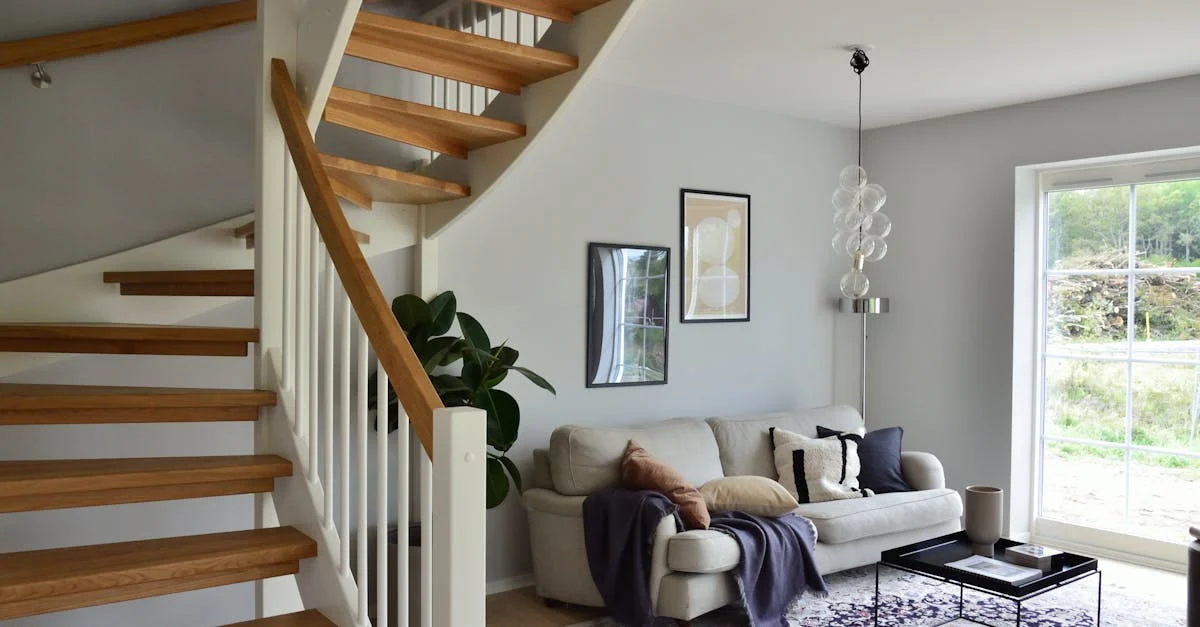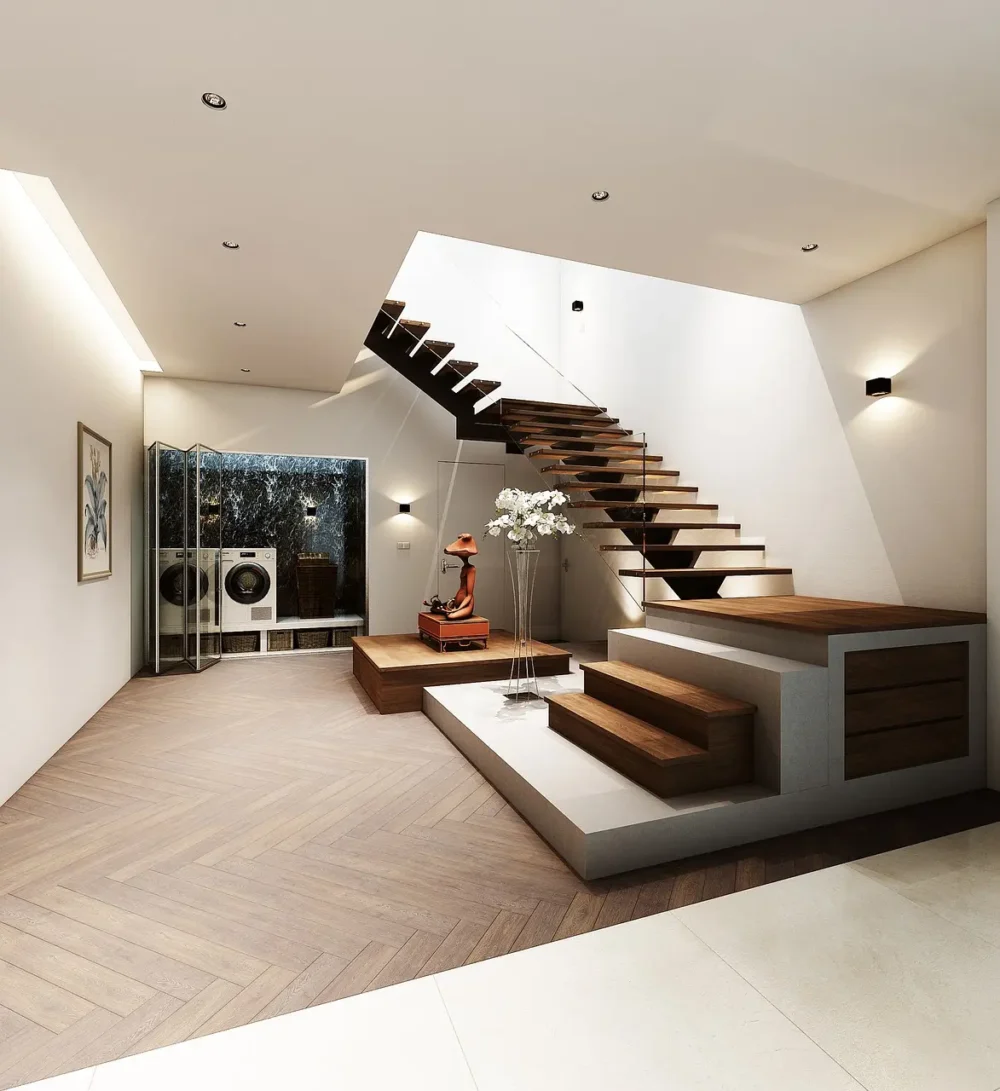Introducing Curvspace Stairways
At Curvspace, we inspire you to transform traditional staircase designs with our innovative twist, featuring smooth, flowing lines that create a sense of elegance and modernity. Unlike standard linear stairs, Curvspace exemplifies artistic design, enhancing both aesthetics and functionality in spaces. Their graceful spaces provide a seamless visual appeal, while the material versatility allows them to be crafted from wood, glass, metal, or stone. This makes stairways suitable for compact spaces and various settings, including residential, commercial, and public buildings. With customization options in size, shape, and materials, our Curvspace stairways meet specific design preferences, making them an ideal choice for enhancing interior decor.
Reader Disclosure
Jump to:
What is a Stairway?
A stairway, also known as a staircase or stairwell, connects different levels in buildings through a consecutive series of steps. These structures serve both functional and aesthetic purposes in architecture. Stairways improve accessibility, providing safe and efficient transitions between floors. They also offer opportunities to enhance interior design.
Several types of stairways exist, each with unique features:
- Straight Stairways: Consists of a continuous row of steps without any changes in direction.
- Spiral Stairways: Feature steps arranged around a central column, creating a spiral design.
- Curved Stairways: Incorporate smooth flowing, often adding an elegant touch to spaces.
- Split Stairways: Divide into two or more flights, often found in grand entrances.
- L-Shaped Stairways: Feature a 90-degree turn, usually with a landing between the flights.
Materials for stairways vary greatly and often include wood, metal, glass, and stone. Each material offers distinct benefits in terms of durability, aesthetics, and cost. For example, wooden stairways provide a classic look and can be less expensive, while metal stairways offer modern appeal and added strength.
Design considerations for stairways encompass factors such as width, step height, tread depth, and handrail placement. Ensuring compliance with building codes and regulations enhances safety and usability. Architecturally, stairways can significantly influence a building’s design narrative, becoming focal points or seamlessly blending into the environment.
The History of Stairways
Stairways have been integral to architectural design since ancient times. Early examples date back to 6000 BCE in the Mesopotamian region, where they served practical and ceremonial functions. The ziggurats of ancient Mesopotamia featured grand staircases leading to temple complexes.
In ancient Egypt, stairways were prominent in pyramid construction. These structures often included internal staircases for the workers and hidden passageways for the pharaohs’ journey to the afterlife. The Greeks and Romans improved stairway designs by introducing more advanced engineering techniques like spiral staircases in watchtowers and amphitheaters.
During the Middle Ages, stone stairways gained prominence in castles and cathedrals across Europe. Medieval castles used narrow, winding staircases for defense, making it difficult for invaders to ascend. Gothic cathedrals showcased elaborate stone stairways, often accompanying grand entrances or leading to choir lofts.
The Renaissance period marked a shift towards elegance and symmetry in stairway design. Architects like Michelangelo and Palladio designed grand staircases in palaces and civic buildings, emphasizing their aesthetic value. The stairways of this era became central elements of architectural composition.
In the 19th and 20th centuries, the Industrial Revolution and modernism brought materials like steel and reinforced concrete into stairway construction. These innovations allowed for more daring and intricate designs, including floating stairs and sweeping helicoidal forms. Architects began to experiment with minimalistic styles and transparent materials like glass to create visually striking stairways.
Stairways have continued to evolve, integrating smart technology and ergonomic designs to enhance safety and functionality. Today, they remain essential components in various architectural projects, reflecting cultural and technological advancements throughout history.
Ancient Mesopotamian ziggurats and Egyptian pyramids, medieval castles and Gothic cathedrals, Renaissance palaces, and modern structures all illustrate the diverse history of stairways.
Purpose of Stairways
Stairways connect different levels within structures, facilitating vertical movement. They provide practical solutions in multi-story buildings, ensuring accessibility and convenience. For example, in residential homes, stairways link floors, while in commercial buildings, they offer emergency exits. Stairways also enhance architectural aesthetics. They can become focal points, highlighted by intricate designs or innovative materials like glass or steel. In public structures, stairways often symbolize grandeur and are used in ceremonial spaces, as evident in grand theaters or government buildings. Functionally and aesthetically, stairways remain integral to architecture.
Types of Stairways
Stairways vary based on design, use, and construction materials. Each type has unique features and serves different architectural purposes.
Straight Stairways
Straight stairways are the most common and simplest type. They consist of a single, linear flight without any change in direction. Examples include residential homes and office buildings.
L-Shaped Stairways
L-shaped stairways, or quarter-turn stairs, include a landing that creates a 90-degree turn. These stairways provide a visual barrier and can offer more privacy between levels. Examples include split-level homes and modern lofts.
U-Shaped Stairways
U-shaped stairways, or half-turn stairs, feature a 180-degree turn at a central landing. They take up less linear space and offer a more compact design. Examples include multi-story commercial buildings and duplex apartments.
Spiral Stairways
Spiral stairways have a helical structure, often centered around a single pole. These stairways save space and add an element of intrigue. Examples include industrial spaces and contemporary residential designs.
Curved Stairways
Curved stairways feature a graceful, continuous curve without angular turns. They often serve as striking architectural elements. Examples include grand entrances and luxury estate homes.
Floating Stairways
Floating stairways create the illusion of steps floating mid-air, typically anchored to a wall or supported by hidden structures. They add a modern, minimalist aesthetic. Examples include high-end contemporary homes and cutting-edge office spaces.
Cantilevered Stairways
Cantilevered stairways have treads fixed at only one end, creating an open, airy feel. These stairways often appear in avant-garde architectural designs. Examples include innovative residential projects and artistic commercial spaces.
Bifurcated Stairways
Bifurcated stairways split into two smaller flights after an initial rise. They offer a grand appearance and direct traffic flow efficiently. Examples include government buildings and large museums.
Each type leverages unique design elements, enhancing architectural aesthetics and functionality. From straightforward straight stairways to elaborate bifurcated designs, stairways continue to evolve, reflecting advancements in materials and engineering techniques.
Contemporary Uses of Stairways
Stairways, more than mere functional elements, have become key design features in contemporary architecture. They act as focal points within spaces, often integrating artistic elements, advanced materials, and cutting-edge engineering techniques.
Public Spaces
In public spaces, stairways often serve as gathering points. For instance, sweeping staircases in museums and libraries provide areas where people can pause, sit, and interact. Civic buildings like courthouses and city halls frequently showcase grand stairways to convey significance and authority.
Residential Design
Within residential design, stairways offer opportunities to express personal style while enhancing functionality. Homeowners might choose sculptural designs like helical stairs or opt for space-saving alternatives like spiral staircases. Floating stairs, using materials like glass and steel, create open, airy spaces, often becoming the home’s centerpiece.
Commercial Buildings
Commercial buildings use stairways for more than navigation; they contribute to branding and user experience. Retail spaces incorporate wide, inviting staircases to encourage movement between floors, enhancing customer flow. Office buildings might use open staircases to foster a collaborative environment, breaking down visual barriers and promoting interaction.
Outdoor Applications
Outdoor stairways play a crucial role in landscape design. They connect different levels within gardens and public parks, providing both aesthetic appeal and practicality. For example, terraced gardens use stone or wooden steps to create tiered sections, enhancing the visual landscape while ensuring easy access.
Accessibility Considerations
Modern stairway design acknowledges the importance of accessibility. Designers integrate features such as handrails, tactile indicators, and appropriate step heights to meet inclusive design standards. In public buildings, stairways are often accompanied by ramps or elevators to ensure accessibility for all users.
Artistic Installations
Some stairways transcend their functional role to become genuine works of art. Examples include the Loretto Chapel’s helix-shaped staircase in Santa Fe, which defies traditional structural logic, and the Spanish Steps in Rome, a blend of utility and grand Baroque architecture. These structures draw visitors, blending form and function in public consciousness.
Architects and designers continue to push the boundaries of stairway design, combining tradition with new materials and technologies to redefine stairways’ role in contemporary settings.
Modern Trends in Stairways Design
Modern stairways showcase innovation and creativity, integrating aesthetics and functionality. These trends highlight key elements, including the use of new materials, minimalist designs, and customized solutions.
Use of New Materials
Architects and designers use materials like glass, steel, and reclaimed wood to add a contemporary touch. Glass stairways create a sense of openness; steel provides an industrial feel; reclaimed wood adds character and sustainability. For instance, combining glass with steel railings gives both transparency and strength.
Minimalist Designs
Minimalism remains popular in modern stairway design due to its clean lines and simplicity. Such designs often feature straight lines, open risers, and hidden supports. By eliminating unnecessary details, minimalist stairways blend seamlessly with modern interiors, making the space look uncluttered.
Customized Solutions
Customization in stairway design reflects personal style and practical needs. Custom stairways cater to unique spatial constraints and design preferences. For example, spiral staircases save space, while floating stairs create an illusion of weightlessness. Bespoke lighting solutions enhance both safety and visual appeal.
Integration with Technology
Technology plays a significant role in modern stairway design. Architects integrate smart lighting, under-step lighting, and motion sensors to improve safety while adding a sleek look. Digital fabrication techniques allow for precise cuts and innovative shapes, ensuring accuracy and creativity.
Sustainability
Eco-friendly materials and practices influence stairway design. Using sustainably sourced wood, recycled materials, and low-VOC finishes helps reduce environmental impact. This approach aligns with the growing demand for green building practices and contributes to overall sustainability goals.
Statement Pieces
Modern stairways often serve as architectural focal points, making bold design statements. Designers create sculptural stairways that draw attention and elevate the interior’s overall aesthetics. Examples include helical staircases with fluid curves and intricately designed balustrades.
By leveraging these modern trends, stairways become more than just functional structures; they transform into integral elements of contemporary design, enhancing both form and function within spaces.

Cultural Diversity in Stairways Design
Stairways showcase cultural diversity when comparing designs from different regions and historical periods. Unique elements arise from cultural practices and available materials.
Asian Stairways
Asian stairways often feature intricate woodwork and symbolism. In Japan, traditional wooden stairs called “Kaidan” are steep and narrow, reflecting spatial efficiency. In China, grand staircases in palaces use marble or stone, incorporating dragon designs symbolizing power.
European Stairways
European stairways in older structures often display grandiose design and elegance. Renaissance Italy saw elaborate staircases with ornate banisters in villas and public spaces. France’s Château de Chambord epitomizes this with its double-helix staircase.
Middle Eastern Stairways
Middle Eastern stairways often integrate geometric patterns and Islamic art. In Iran, historic structures like Masjed-e Jāmé feature spiral staircases with intricate tile work and calligraphy, showing religious and artistic influences.
African Stairways
African stairways often use local materials and showcase cultural artistry. In Mali, the Great Mosque of Djenné has adobe stairways with wooden stakes for maintenance. The design reflects both functionality and local craftsmanship.
American Stairways
American stairways exemplify a blend of styles reflecting immigration and innovation. Colonial homes feature simple wooden staircases, while modern structures may use floating staircases with glass and steel, epitomizing contemporary trends.
Impact of Modernism
Modernism introduces minimalistic designs without sacrificing cultural uniqueness. Architects across regions now blend traditional elements with modern materials and concepts. This results in stairways that honor cultural heritage while embracing innovation.
Curvspace Qualities of Stairways
At Curvspace, we inspire you to transform your stairways with qualities that significantly impact their visual appeal, functionality, and integration within architectural design. Create a sense of movement and fluidity, making spaces feel more dynamic.
Smooth Transitions
Stairways deliver smooth transitions between different levels of a building. This seamless connection enhances user comfort and safety by reducing abrupt changes.
Aesthetic Appeal
Stairways designs elevate aesthetic appeal with their graceful curves and flowing lines. These elements often become focal points in contemporary architecture, drawing attention and adding sophistication.
Space Optimization
Stairways optimize space, especially in constrained areas. By curving along walls or around central points, these stairways make efficient use of available space without compromising functionality.
Structural Integrity
Architectural integrity plays a crucial role in curvspace stairway designs. Advanced materials like concrete and steel ensure that the maintain strength and durability despite their complex shapes.
Versatility in Design
Stairways provide designers with versatility. I notice that their adaptability allows for various styles and configurations, from spiral to helical designs, catering to diverse architectural visions.
Integration with Interior Design
Stairways can seamlessly blend with interior design elements. By aligning with the overall design theme, they enhance coherence and unity within the space.
Enhanced Safety Features
Enhanced safety in curvspace stairways includes features like gentle curves and handrails. These aspects provide additional support and reduce the risk of accidents, especially in high-traffic areas.
Use of Natural Light
Natural light plays a significant role in curvspace stairway designs. By incorporating large windows or strategic placement, these stairways leverage natural light to brighten spaces and highlight their curvilinear beauty.
Incorporation of Modern Materials
Modern materials such as glass, steel, and concrete are often used in curvspace designs, ensuring robustness and aesthetic allure. For example, a glass railing on a curved stairway can create an open, airy effect.
Customization Possibilities
Curvspace stairways offer extensive customization options. From selecting materials to determining curve radii, designers can tailor every aspect to meet specific needs and preferences.
The curvspace qualities of stairways not only enhance their visual impact but also contribute to their practical and structural advantages, making them a popular choice in modern architecture.
People Also Ask
What is the historical significance of stairways in architecture?
Stairways have been essential architectural elements since ancient civilizations. They served both practical and ceremonial purposes in structures like ziggurats and pyramids, symbolizing ascension and connection with the divine.
How have engineering advancements influenced stairway design?
Engineering advancements have allowed architects like Michelangelo and Palladio to push the boundaries of stairway design. The introduction of materials such as steel and concrete during the Industrial Revolution further revolutionized stairway construction.
What are some common types of stairways?
Common types of stairways include straight, spiral, curved, and bifurcated designs, each offering unique aesthetic and functional benefits tailored to different architectural needs.
How are stairways used in contemporary architecture?
In modern architecture, stairways are not just functional but also key design features. They often serve as statement pieces that enhance both the form and function of spaces, integrating new materials and minimalist designs.
What materials are popular in modern stairway design?
Popular materials in modern stairway design include glass, steel, and reclaimed wood, allowing for a blend of transparency, strength, and sustainability.
How do different cultures influence stairway design?
Cultural influences shape stairway design significantly. For example, Asian stairways often feature intricate woodwork, while European stairways may showcase grandiose elegance. Each region uses local materials and craftsmanship methods.
What is Curvspace in stairway design?
Curvspace inspires the use of different forms in stairway designs. These designs enhance visual appeal, optimize space, ensure structural integrity, and offer versatility and customization in modern architecture.
Conclusion
Stairways have evolved from mere functional elements to significant architectural features that blend tradition with innovation. Their journey from ancient monuments to modern masterpieces showcases their versatility and enduring appeal. In contemporary architecture, stairways are more than just a means of vertical movement; they’re central to aesthetic and functional design. By embracing new materials and technologies while honoring cultural heritage, architects continue to redefine the role of stairways in our built environment. Whether through minimalist designs or elaborate structures, stairways remain integral to the narrative of architectural progress. At Curvspace, we inspire you to transform the stairway’s essential features into more functional, beautiful, and enjoyable places for everyone.
Show & Tell
We’d love to hear your thoughts about these ideas! Simply click the link to head over to your favorite platform and add your comments about this post there. We’d like to know about your insights, questions, or just saying hi.
More Curvspace Topic Pages
Disclosure
Our content is reader-supported. This means if you click on some of our links, then we may earn a commission. Commissions do not affect our editor’s opinions or evaluations. Learn more about our editorial process.

About the Editorial Staff
The Curvspace editorial team comprises a diverse group of experts on intermediate and threshold spaces in homes and workplaces. Architects and interior designers, civil engineers and artists, environmental and behavioral psychologists, sociologists and anthropologists. All collaborate to create helpful content, that explores the full potential of these often-overlooked areas to enhance our daily lives.


